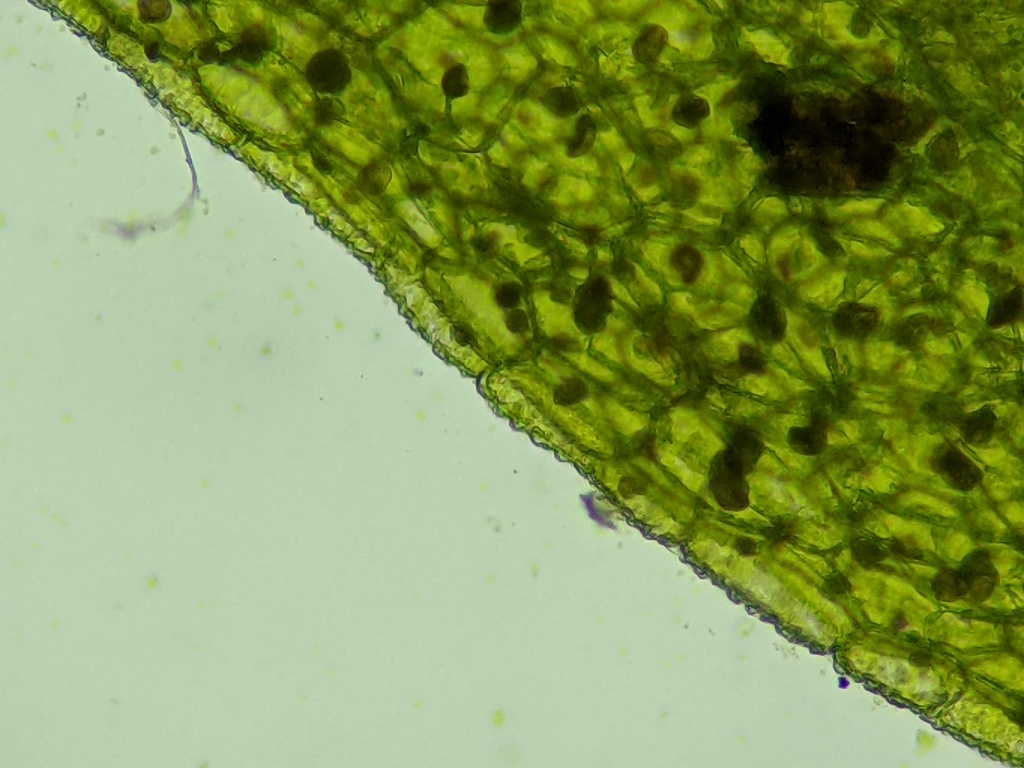Aneuraceae
Terrestrial, lithophytic or epiphytic, rarely subterranean (not in Victoria), monoicous or dioicous with female and male plants of similar size or rarely male plant much smaller than female plant (not in Victoria). Asexual reproduction by gemmae on adaxial thallus surface. Plant comprising a fleshy simple or irregularly, palmately or 1–3-pinnately branched thallus lacking a distinct midrib; thallus green or rarely colourless (not in Victoria), multistratose, sometimes unistartose at margins, often brittle, adaxially flat and convex abaxially, concave adaxially or terete, biconvex or elliptic in cross-section, smooth or striate, rarely covered with hairs (not in Victoria) or with longitudinal crests abaxially (not in Victoria), without air chambers, without air pores; thallus cells polygonal, thin to somewhat thick-walled, without distinct trigones, with numerous small oil bodies or with few larger oil bodies. Abaxial scales absent. Rhizoids when present scattered over central or entire abaxial thallus, without internal peg-like thickenings, hyaline or brown. Antheridia sunken in chambers on short lateral branches or rarely in sunken or emergent perigonial chambers on the leading thallus (not in Victoria), in two regular or 2–4 irregular rows. Sporophytes on short lateral or abaxial branches or rarely adaxial on the leading thallus (not in Victoria), medially on adaxial surface (not in Victoria), marginally between lobes or on the abaxial side of margin, surrounded by a shoot calyptra; calyptra clavate, fleshy; involucre absent; pseudoperianth absent. Seta elongate. Capsules ellipsoid to cylindric (not in Victoria), bistratose, dehiscence by 4 valves; elaters present, unispiral, rarely bispiral (not in Victoria). Spores globose, papillose or rarely areolate (not in Victoria), brown or greenish brown, shed singly or in tetrads (not in Victoria).
Five genera and 349 species throughout the world, except for poles (Söderström et al. 2016; Rabeau et al. 2017); three genera and 12 species in Victoria.
Many species in this family supplement their nutrition through symbiosis with the basidiomycete fungi of the genus Tulasnella, which form ectomycorrhizal associations with tree species (Wickett & Goffinet 2008; Preußing et al. 2010). Two of the species of Aneura, previously recognised as the separate genus Cryptothallus, have become non-photosynthetic, white and completely reliant on Tulasnella for their nutrition (i.e. obligately myco-heterotrophic) and are the only known cases of complete dependence of all parts of the life cycle on fungi among the bryophytes or the non-seed plants (Wickett & Goffinet 2008).
Preußing, M., Olsson, S., Schäfer-Verwimp, A., Wickett, N.J., Wicke, S., Quandt, D. & Nebel, M. (2010). New insights in the evolution of the liverwort family Aneuraceae (Metzgeriales, Marchantiophyta), with emphasis on the genus Lobatiriccardia. Taxon 59: 1424–1440.
Rabeau, L., Gradstein, S.R., Dubuisson, J.-Y., Nebel, M., Quandt, D. & Reeb, C. (2017). New insights into the phylogeny and relationships within the worldwide genus Riccardia (Aneuraceae, Marchantiophytina). European Journal of Taxonomy 273: 1–26.
Söderström, L., Hagborg, A., von Konrat, M., Bartholomew-Began, S., Bell, D., Briscoe, L., Brown, E., Cargill, D.C., Costa, D.P., Crandall-Stotler, B.J., Cooper, E.D., Dauphin, G., Engel, J.J., Feldberg, K., Glenny, D., Gradstein, S.R., He, X., Heinrichs, J., Hentschel, J., Ilkiu-Borges, A.L., Katagiri, T., Konstantinova, N.A., Larraín, J., Long, D.G., Nebel, M., Pócs, T., Puche, F., Reiner-Drehwald, E., Renner, M.A.M., Sass-Gyarmati, A., Schäfer-Verwimp, A., Moragues, J.S., Stotler, R.E., Sukkharak, P., Thiers, B.M., Uribe, J., Váňa, J., Villarreal, J.C., Wigginton, M., Zhang, L. & Zhu, R. (2016). World checklist of hornworts and liverworts. Phytokeys 59: 1–828.
Wickett, N.J. & Goffinet, B. (2008). Origin and relationships of the myco-heterotrophic liverwort Cryptothallus mirabilis Malmb. (Metzgeriales, Marchantiophyta). Botanical Journal of the Linnean Society 156: 1–12.
 Spinning
Spinning